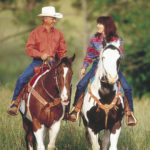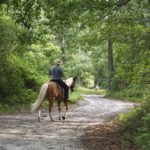October in Montana: The summer heat has been put to sleep, the insects have been quelled by nightly frosts, and the woods are aflame with color. For those of us who ride in the northern Rockies, fall means brilliant yellow aspens threading groves of dark spruce.

Creeks are clear and cold, and the air is freshened by a trace of bite. The warmth rising from your horse after climbing the grade is now welcome. A down vest feels good. It’s the best time of the year to ride a horse.
Everything comes alive in the fall, as nature enjoys a shot of adrenalin, a final bloom, before the onset of winter. Horses are spirited, their riders energetic, the trails more inviting than ever.
In my area, there’s an added bonus: trail use, by both riders and hikers, drops drastically after Labor Day. Indeed, I avoid one of my favorite trailheads, one that’s both beautiful and heavily used, until September. Then, particularly midweek, I often have it to myself.
Thoughts of backcountry trips invoke memories of the scent of pine smoke curling from the woodstove of my wall tent, mingling with the aroma of campfire coffee while I watch my horses graze on their picket lines.
But this beautiful season of the year presents some challenges for the trail rider. Indeed, autumn seems to be the time in which many trail riders, ill prepared, run into serious difficulties.
Prepare for Weather
Far and away the most formidable challenge is to ride properly prepared for weather that may take a 180 degree turn. Fall weather is inherently fickle. Throw in the effects of high altitude, and it can go from balmy to dangerous in an hour?s travel on a fast-walking horse.
You might embark on a fall ride in the warm sun. But within a few hours, especially if you gain altitude, you may quickly become wet from an icy drizzle, and even in an early snowfall. You may think your ride will be a short one. Then you find a trail closure that requires a long detour. Or, far worse, you or a companion, human or equine, gets sick or hurt.
Suddenly, everything has changed. You may be involved in a waiting game that will test your clothing and preparedness to the ultimate. Most outdoor survival situations occur relatively close to trailheads or other accoutrements of civilization, and people who have been through them stress how quickly they can occur.
Cold rain can be dangerous, since soaked skin at chilly temperatures can bring on hypothermia. A slicker alone won?t do it ? rain will find its way in, and something warm underneath is essential.
Among mountaineers and outdoor guides, two words say it all: Cotton kills! Yes, you sometimes see a cotton layer touted for wicking ability. Wrong, wrong, wrong. Cotton gets wet, stays wet, and loses all insulating capacity. Seasoned outdoor people who challenge difficult conditions get rid of it completely.
If you’re tackling high-altitude trails in autumn, consider underwear made from a silk/wool blend, layers of fleece, and, best of all, wool.
Down is wonderful when dry, but turns to mush when wet. When the drizzle starts, I stuff my down vest into a saddlebag and replace it with something that retains insulating properties.
Watch for Wildlife
Be aware, too, that wildlife activity kicks up during fall. I think of this as a bonus, not a worry. During fall, moose, bears, and elk spend less time fighting flies in the deep shadows, as they do during the heat of summer, and migratory birds are on the move.
Most animals are intent on feeding, on acquiring that layer of fat that will nourish them during winter. Seeing them, camera in hand, is a great thrill. But it’s important to note that wild animals are just that ? wild. Very few pose any real danger, but stay out of their space.
A cow moose with a calf can be extremely protective, and you don’t want to get between a bear and her cubs. If you ride in grizzly country, as I do, you learn to be particularly watchful.
None of this should intimidate or discourage you from riding in the year?s most beautiful season. It’s just that autumn is a transition season, and you must be prepared for instances when the transition occurs more suddenly than anticipated.
Consider Your Horse
Our horses, too, are in transition. If your summer season has been active, your horse is likely to be in fine condition, much better than he was on those first spring rides. Hooves tend to harden and slow in growth as winter approaches, and that’s all to the good.
The year?s first frost points toward greater attention to traction on the trail. I frequent trails that alternate from mud to gravel to terribly jagged granite ledges blasted out of the sides of cliffs. While I may be happy with rim shoes during midsummer, the possibility of such footing being overlaid with frost and snow nudges me toward shoes with toe and heel caulks during fall.
It’s usually on a chilly morning in late September or early October, when clear sky promises balmy temperatures later in the day, that I notice something different about my black gelding as he stands by the gate waiting for a palm-full of oats. There’s a new sheen to his coat, a velvet overlay, and I realize that his winter hair is coming.
The last thing the wise trail rider who lives in northern climes wants to do at this point is to put a protective blanket on that wonderful seasonal coat. Blanketing horses to prevent the growth of winter hair is a show ring anomaly that has no place in managing the trail horse. He needs that hair. Why prevent its growth and then attempt to supply the same amount of insulation artificially, with a blanket?
And, if rugged trail duty lies ahead, I’m not quick to trim fetlock hair or to scalp my horse’s ears with an electric clipper. Why trim away the horse’s natural protection against cold, against trail abrasions, against that first crusted snow through which you’ll ride?
Have Fun!
Okay, enough with the warnings, the cautions, the tips ? let?s enjoy. I head this late-September morning toward that favorite trailhead, the one I avoid during summer, knowing that on a Tuesday in the fall, I’ll have it to myself.
The highway threads through Montana foothills bedecked with buck brush now turned scarlet, toward blue mountains capped on their very tops with new snow. I turn off the truck?s air conditioner and open the driver?s window.
The trailhead parking lot is nearly empty of vehicles, only a car or two, a pickup of Forest Service green and the gooseneck trailer of an outfitter I know. They’ll be far up the drainage, farther than I’ll ride today.
I back Partner out of the two-horse trailer, curry him, and saddle up. I’m going alone, so I double-check my pommel packs for the usual necessities: first-aid kit; extra food; water; map; compass; global positioning system; cell phone (turned off to save battery and sanity); and fire-making supplies.
I wrap a wool vest in my rain jacket, roll them together, and tie them behind the cantle.
(For more on riding alone, visit MyHorse.com, and enter ?riding solo? into the site?s search engine; for more on navigation, enter ?map? into the search engine.)
Then, with a final check of my cinch, I’m up and we’re off at a swift single-foot, Partner?s rein chains jingling. We cruise past the trailhead signs and ascend the ledge trail along the frothy river, now somewhat tamed by the lower water level of the season.
Pretty little birds called water ouzels flit and dart above the emerald pools sandwiched between runs of white water. The fresh breeze that meets me on the trail is scented with pine.
On top of the gorge, we find the river gentled now, a series of deep blue pools. I wave back to a fly fisherman who?s edging his way toward deeper water. (He ends up being the only person I see on this day ride.) Then it’s up a grade, away from the river, through aspen groves whose signature golden leaves quiver in the morning breeze.
We cross a trail bridge over a small tributary creek, then, five minutes later, we ford another. I stop so that Partner can drink.
We ride for another hour, finally topping a ridge for the view I?ve come to see, the valley opening to the south, the river emerging from a wall of granite. Over these mountains, traversed by a high pass, lie streams that run down into Yellowstone Park. I?ve crossed these mountains, but today my purpose is to merely ride a good horse in beautiful surroundings in cool sunshine.
Far below me in a meadow, scarcely larger than dots at this distance, graze a cow moose and her calf. They?re the icing on the cake. I can now turn toward home, my spirit renewed by a ride of the best possible sort, an autumn ride.
Happy (fall) trails!
About the Author
Dan Aadland raises mountain-bred Tennessee Walking Horses and gaited mules on his ranch in Montana. His most recent books are In Trace of TR; The Best of All Seasons; The Complete Trail Horse; and 101 Trail Riding Tips. For information on Aadland?s horses, books, and clinics, visit http://my.montana.net/draa.
?






